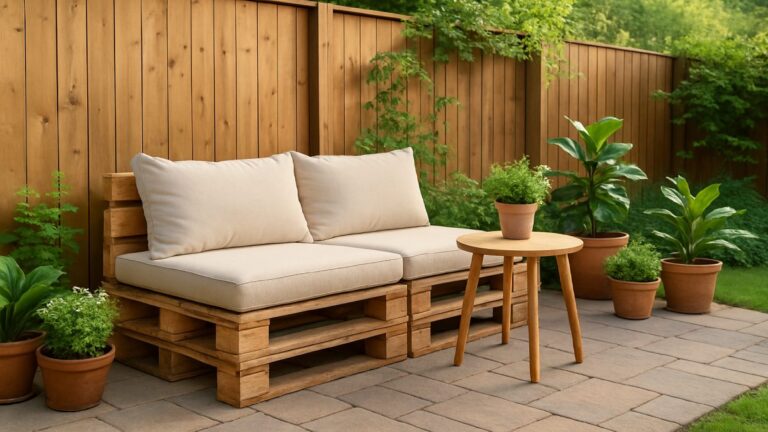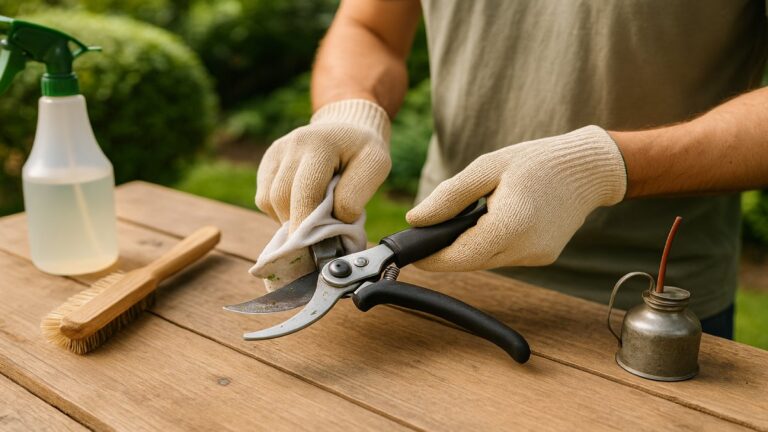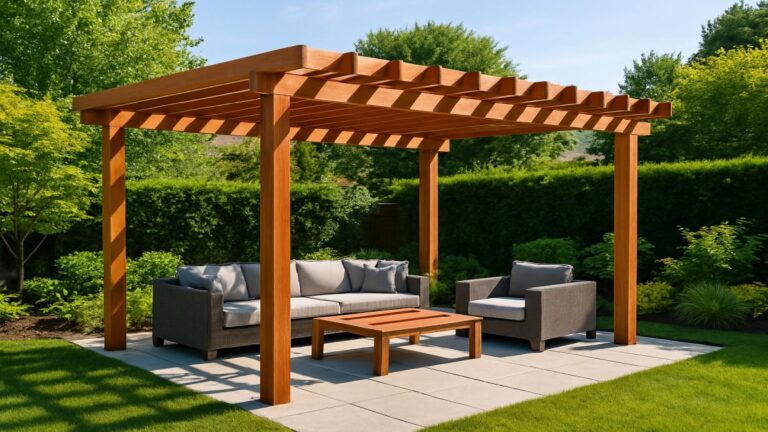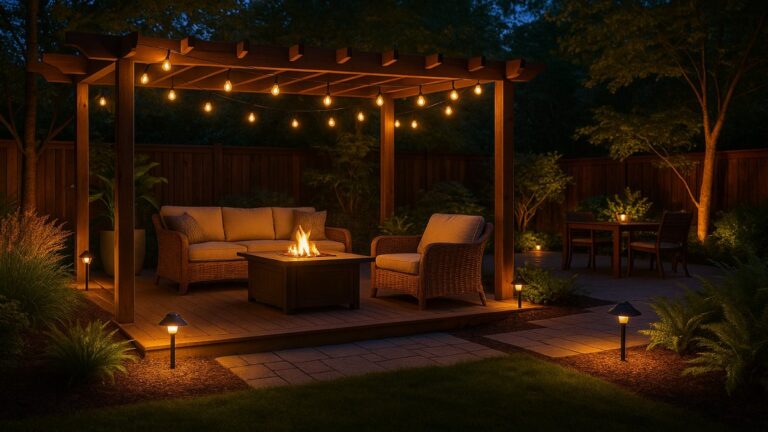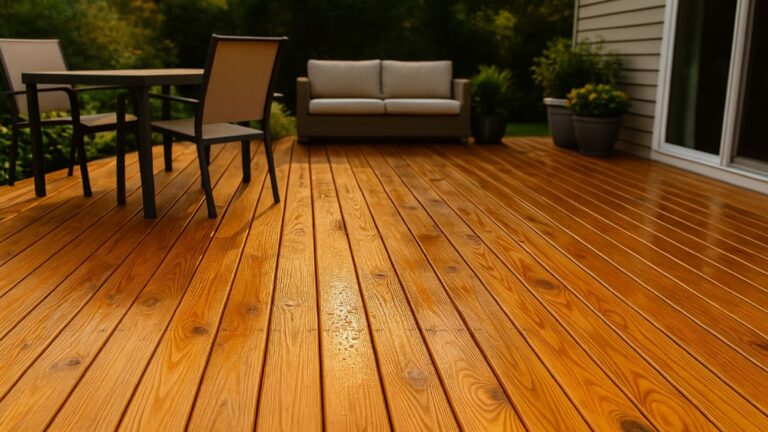Move Houseplants Outdoors Safely: Summer-Ready Tips
Warm weather brings brighter days, longer evenings, and a chance to give your indoor plants a little “summer vacation.” Fresh air, natural light, and humidity can spark new growth, deepen leaf color, and boost overall vigor. You’ll see sturdier stems, larger leaves, and a fuller shape when the transition is done right. This guide shows you how to move indoor plants outdoors during the warm months safely, without leaf burn or shock.
The method is simple: wait for steady warm nights, ease plants into brighter conditions over a couple of weeks, adjust watering and feeding, and keep a close eye on wind, rain, and pests. When fall returns, bring them back inside with the same level of care. Follow the steps below and your houseplants will come back indoors greener, stronger, and happier than before.

Why Move Indoor Plants Outside in Warm Weather
Outdoor conditions deliver what many houseplants miss indoors: broad-spectrum natural light, higher humidity, and livelier air movement. That combination fuels photosynthesis and supports sturdier growth. Many tropical foliage plants—philodendron, pothos, monstera, peace lily—respond with deeper color and fresh leaves after a few weeks outside. Even succulents and cacti benefit when they’re eased into stronger sun and kept on the dry side.
There’s also a rhythm benefit. Winter often means lower indoor light and slower growth. A warm-season reset helps plants rebuild energy reserves and grow new roots. You get fuller containers for summer display and healthier plants heading into winter. The key is timing and a calm, step-by-step acclimation process that respects each plant’s light tolerance.
Timing: Night Temperatures and Frost-Free Windows
Set your calendar by nighttime lows, not just daytime highs. Wait until nights are consistently around 60°F (15–16°C) or warmer for at least a week. That threshold protects tender foliage from cold shock and supports steady metabolic activity. Give your area a buffer of a few weeks past the last frost date before you begin hardening off, especially if spring weather is erratic or your patio is exposed to wind.
Regional Timing Tips
- Cooler climates: Late spring to early summer works best. Be patient with night temps and hold plants indoors if a cold snap appears in the forecast.
- Moderate climates: Late spring is often safe. Start hardening off once the 10-day forecast keeps nights above 60°F.
- Warm climates: Spring arrives early, but be mindful of sudden heat waves. Acclimate slowly to avoid sunburn when intensity jumps quickly.
Best Time of Day to Move Plants
Begin transitions in the early morning or late afternoon. Gentle light reduces stress on Day 1 and helps leaves keep moisture. Avoid first-day noon sun on any plant that hasn’t been outdoors yet; even “sun lovers” can scorch when moved too quickly.
Hardening Off: A 10–14 Day Acclimation Plan
Hardening off is the controlled introduction to outdoor conditions—shade, breeze, and a wider light spectrum. The process teaches leaves and roots to handle higher UV, changing temperatures, and quicker evaporation. Stick to this schedule and most houseplants will adapt without drama.
Stage 1: Full Shade, Short Visits (Days 1–3)
- Place plants outdoors in deep shade for two to four hours. Patios with a roof, under-deck zones, or the north side of a fence are ideal.
- Bring them back indoors after the session or into a protected porch overnight if temperatures are steady.
- Watch for subtle signs of stress: droop that doesn’t improve by evening, limp petioles, or pale patches.
Stage 2: Bright Shade or Dappled Sun (Days 4–7)
- Increase time outdoors to half days in bright shade or dappled light under a tree canopy.
- Rotate pots so all sides see similar conditions. This encourages even growth and keeps plants from leaning.
- Variegated foliage and thin leaves scorch first. Keep these plants on the shadier side during this stage.
Stage 3: Full Days Outside (Days 8–14)
- Leave plants outdoors from morning to evening. If nights remain above 60°F, they can stay out overnight in protected spots.
- Begin gentle sun trials for plants that prefer more light. Start with early morning rays for 30–60 minutes and step up slowly.
- Dial in watering; soil will dry faster outdoors. Check moisture with your finger two knuckles deep before every watering.
Stress Signals to Catch Early
- Sunburn: White or tan patches that feel papery. Move to brighter shade and trim only after new growth appears.
- Wilting in heat: A brief midday droop can be normal in warm spells. If plants remain limp at night, increase shade and water earlier in the day.
- Leaf curl or crisp edges: Too much wind or a hot, reflective surface nearby. Add a wind break and shift the pot.
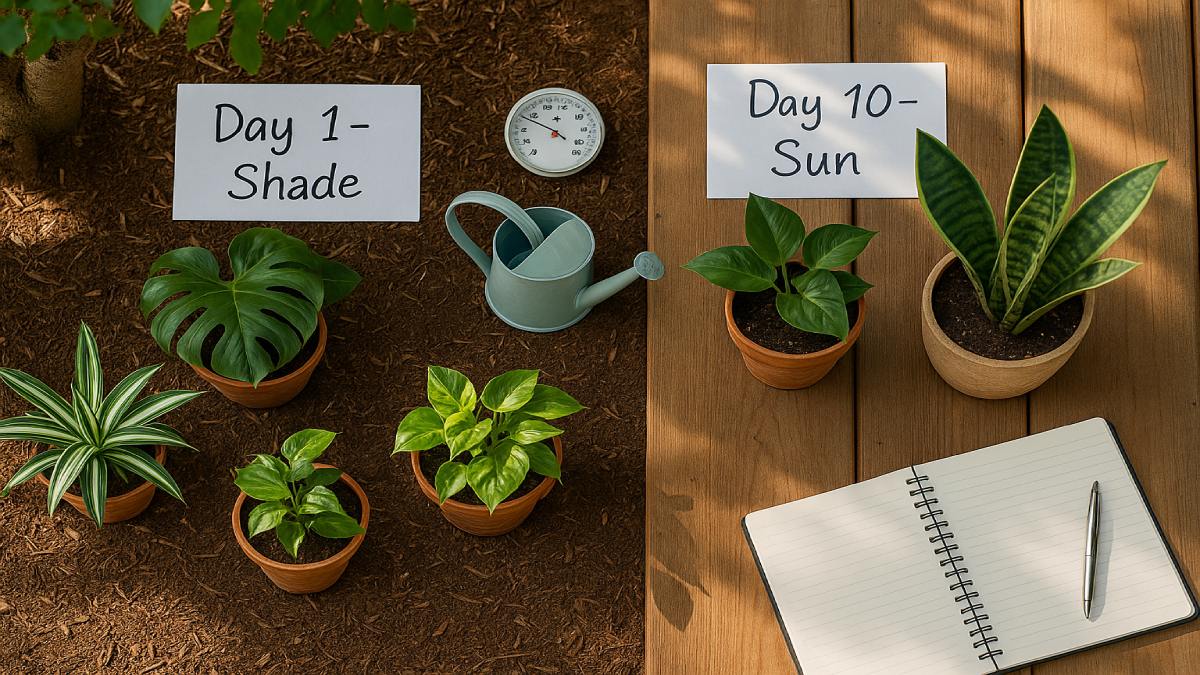
Where to Place Plants Outdoors: Light, Wind, and Rain
Match placement to a plant’s true light needs and your site’s microclimates. Most houseplants prefer bright shade outdoors, not full midday sun. Eastern exposures offer soft morning rays that are easier on leaves. Western exposures get harsher afternoon light; reserve that for sun-tolerant species only.
Light Matching by Plant Type
- Low light: Pothos, snake plant, ZZ plant, Chinese evergreen thrive in bright shade or a north-facing wall.
- Medium light: Philodendron, peace lily, dracaena enjoy indirect light or blended morning sun.
- High light: Succulents, cacti, citrus, rosemary can handle stronger sun after careful acclimation.
Wind and Storm Protection
- Use fences, hedges, or corner walls to tame gusts. Group containers to create a humid pocket and shared shelter.
- Shift delicate plants under cover before summer thunderstorms. Heavy rain compacts soil and can snap tender stems.
- Stabilize tall pots with hidden weights (river stones or bricks). Wider, heavier containers tip less.
Rain, Drainage, and Saucers
- Every outdoor container needs drainage holes. Standing water invites root rot.
- Lift pots on risers or pavers. This keeps air moving under the container and helps water escape.
- Empty saucers after storms; use them sparingly to avoid mosquito breeding and waterlogging.

Watering and Feeding: New Rhythm for Outdoor Life
Outdoors, soil dries faster from sun and breeze. Terracotta accelerates evaporation; glazed or plastic containers hold moisture longer. Learn each pot’s pace and water before stress shows up, not after. Early morning is best—leaves dry quickly, roots drink deeply, and you avoid afternoon scorch.
Daily Moisture Checks
- Use the finger test two knuckles deep. If it feels nearly dry, water until you see a steady trickle from the hole.
- For large pots, water in two rounds a few minutes apart. The second pass pushes moisture deeper and prevents dry pockets.
- Mulch the surface with fine bark or coconut husk chips to slow evaporation and keep roots cooler.
Fertilizing During Active Growth
- Feed lightly with a balanced liquid fertilizer every two to four weeks. Half-strength works well for most foliage plants.
- Orchids, ferns, and other sensitive plants prefer gentler schedules. Err on the side of lighter feeding until you see steady growth.
- Flush containers once a month with plain water to prevent fertilizer salt buildup.
Rain Strategy
- Move delicate plants under cover before big storms. If they get drenched, hold off watering until the top few inches dry out.
- Avoid leaving pots in constant rain zones under roof valleys or unclipped gutters.
- Loosen compacted soil with a chopstick and top off with fresh mix if water starts pooling.
Common Outdoor Risks and How to Prevent Them
Sun intensity, heat spikes, strong wind, and opportunistic pests are the big four. Most issues are easy to prevent with early checks and small adjustments. The goal is steady growth, not perfection—plants adapt well with gentle guidance.
Sunburn vs. Sun Stress
- Sun stress: Temporary midday droop that recovers by evening. Provide shade during the hottest part of the day.
- Sunburn: Pale, crispy patches that don’t heal. Shift to brighter shade and prune only after new growth appears.
- Reflective surfaces: Pale stone, glass, or white siding can magnify heat. Place a screen or move pots a few feet away.
Heat Waves
- Water early, then again lightly in late afternoon for shallow-rooted plants if needed.
- Use breathable shade cloth to cut intensity without trapping heat.
- Mist foliage for humidity on tropicals, but keep succulent leaves dry.
Wind and Tipping
- Anchor tall plants to a discreet stake. Use soft ties that won’t cut into stems.
- Lower the plant’s center of gravity with heavier soil topdressing or a hidden stone layer.
- Turn large pots a quarter turn every week to balance growth and reduce leaning.
Pests You’re Likely to See
- Aphids and whiteflies: Rinse with a firm spray, then treat with insecticidal soap if needed.
- Spider mites: Look for stippling on leaves. Increase humidity and treat early with neem oil or a miticide labeled for ornamentals.
- Mealybugs and scale: Dab with alcohol on cotton swabs, then follow up with horticultural oil to smother eggs.
Popular Houseplants That Thrive Outdoors
Many indoor favorites appreciate warm air and gentle sun after a slow winter. Ease them out carefully and match their outdoor seat to their natural habits. Here are reliable picks and notes to keep them looking great all season.
Tropical Foliage
- Monstera and split-leaf types: Bright shade or soft morning sun; protect from hot wind.
- Pothos and philodendron: Dappled light is their sweet spot. Trailing stems thicken outdoors.
- Peace lily: Even moisture and filtered light keep blooms coming; avoid hot, dry spots.
Flowering Favorites
- Begonias and impatiens: Love shade with steady moisture. Perfect for covered porches.
- Anthurium: Bright shade, warm temperatures, and light monthly feeding for glossy spathes.
- Hibiscus: Sun-tolerant after acclimation; needs a bit more water in heat.
Succulents and Cacti
- Ease into sun very slowly. Start with an hour of morning light and build from there.
- Use gritty, fast-draining mix and containers with large drainage holes.
- Keep foliage dry; water deeply and infrequently once the mix is almost dry.
Plants to Keep Indoors
- African violet: Delicate leaves scorch and spot easily outdoors.
- Thin-leaf calatheas: Sensitive to dry air and wind; keep in stable indoor humidity.
- Ferns in hot, dry regions: Can crisp quickly; only move outside if you can keep them in cool shade with high moisture.
Bringing Plants Back Indoors in Fall
As days shorten and nights cool, prepare a smooth return. Don’t wait for the first cold blast to rush the process. Start early and re-acclimate to indoor light over one to two weeks, using the same calm approach you used in spring—just in reverse.
When to Head Inside
- Plan the move when nights dip toward the mid-50s (around 55°F/13°C).
- Begin by moving plants from sun to shade outdoors for a few days.
- Then bring them into bright indoor windows before settling them back in their usual spots.
Inspect, Treat, and Quarantine
- Check tops and undersides of leaves, stems, and soil lines with a small flashlight or magnifier.
- Shower plants to dislodge hitchhikers. Follow with neem, insecticidal soap, or horticultural oil if you spot pests.
- Quarantine new arrivals and returning plants for 10–14 days away from established indoor collections.
Post-Move Care Indoors
- Expect a brief pause in growth as plants adapt to lower light. Reduce feeding until days lengthen again.
- Trim damaged leaves after new growth starts. This keeps plants tidy and focused on healthy tissue.
- Rotate pots monthly to keep growth balanced through winter.
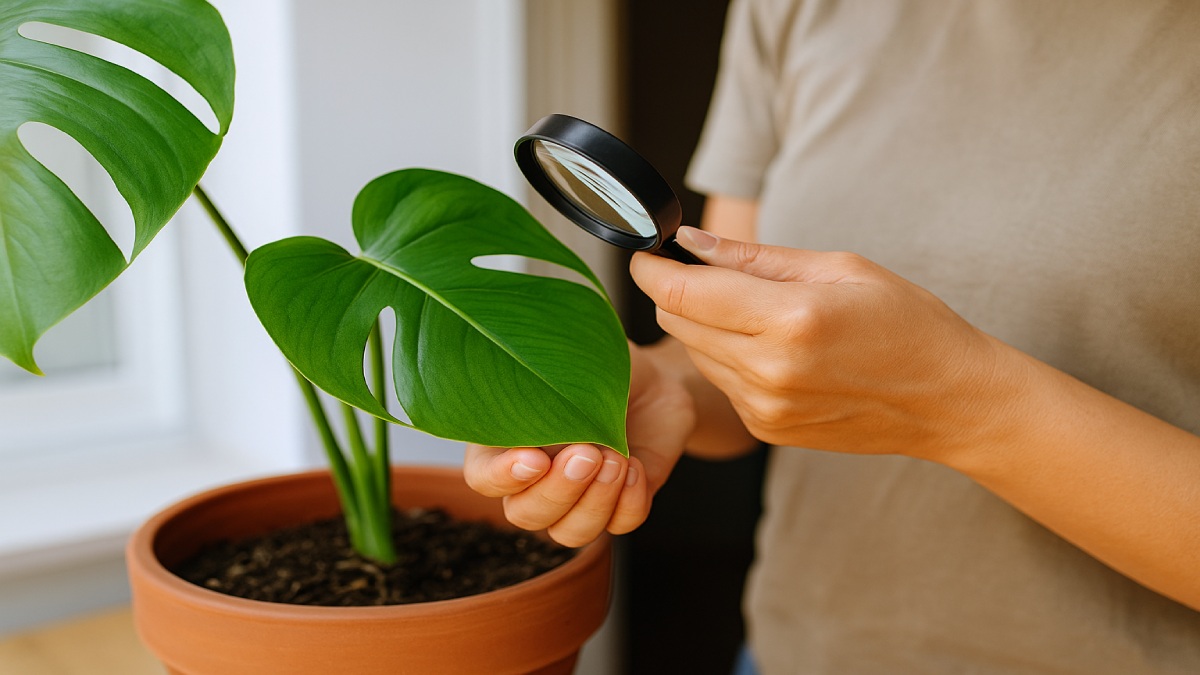
Care Schedules and Simple Routines
Steady routines beat complicated plans. A quick daily glance and a weekly checklist keep issues small. Use a notes app or calendar reminders for feeding, flushing salts, and rotating pots. Those tiny habits deliver the biggest long-term gains.
Daily Five-Minute Check
- Feel the soil, scan for pests, lift pots to judge moisture by weight.
- Open or close shade cloth as the forecast changes.
- Nudge containers if one side is stretching toward light.
Weekly Tasks
- Wipe dust from leaves so light penetration stays high.
- Snip yellow leaves and leggy stems to redirect energy.
- Top off mix where settling exposes roots; replace lost mulch.
Monthly Maintenance
- Flush pots with plain water to remove fertilizer salts.
- Check drainage holes for clogs and clear algae or moss buildup.
- Refresh a light layer of bark or husk chips to maintain moisture and a clean look.
Troubleshooting: Quick Fixes for Common Problems
Even careful gardeners see issues pop up. Treat symptoms as signals, not failures. Small adjustments usually fix the root cause. Here’s a rapid guide to the most common outdoor problems and what to do next.
Leaves Turning Pale or Crispy
- Move the plant into brighter shade or morning sun only.
- Feed at half strength if growth is slow and soil is healthy.
- Trim only when new growth has resumed.
Constant Wilting by Evening
- Water earlier and more deeply. Mulch to slow evaporation.
- Check for rootbound pots; upsize one notch if roots circle the edge.
- Break wind with a screen or move behind a hedge.
Mushy Stems or Sour-Smelling Soil
- Reduce water and improve drainage. Shift to a faster-draining mix.
- Repot and prune soft, damaged tissue. Let the plant dry between waterings.
- Keep out of heavy rain until roots re-establish.
Sticky Leaves, Webbing, or Cottony Clumps
- Rinse thoroughly. Apply insecticidal soap or neem, repeating as labeled.
- Isolate the plant from others until you’re sure the issue is cleared.
- Encourage beneficial insects outdoors by avoiding broad-spectrum sprays.
FAQ: Quick Answers for Fast Decisions
When is it safe to move indoor plants outside?
Wait for nights near 60°F for at least a week and a comfortable buffer past the last frost date. That stability prevents cold shock and sets plants up for steady growth.
Do houseplants need full sun outdoors?
Most do best in bright shade or morning sun only. Ease sun-loving plants into direct light slowly. Thin and variegated leaves scorch first, so give them gentler conditions all summer.
How often should I water outside?
There’s no one schedule. Check daily until you learn each pot’s pace. Water deeply when the top inch or two is nearly dry. Terracotta dries fastest; glazed or plastic pots hold moisture longer.
Should I fertilize during summer?
Yes—light, regular feeding supports active growth. Half-strength liquid fertilizer every two to four weeks works well for most foliage plants. Flush with plain water monthly to prevent salt buildup.
When should I bring plants back indoors?
Head inside when nights trend toward the mid-50s. Reacclimate to indoor light over a week or two, inspect for pests, and isolate new arrivals before returning them to your main collection.
Wrap-Up: A Calm Plan for a Lush Summer
Moving houseplants outdoors during warm months doesn’t have to be stressful. Start with stable night temperatures, ease plants into brighter light, and match each pot to a sheltered spot with good airflow. Water deeply, feed lightly, and stay alert to heat, wind, and rain. When fall arrives, reverse the steps and welcome your plants back inside with careful inspections and a slower pace.
Small, steady habits make the difference: a daily glance, a weekly tidy, and a timely move in or out. Follow this rhythm and your indoor plants will enjoy a healthy summer outdoors—and reward you with lush growth that lasts through the year.

